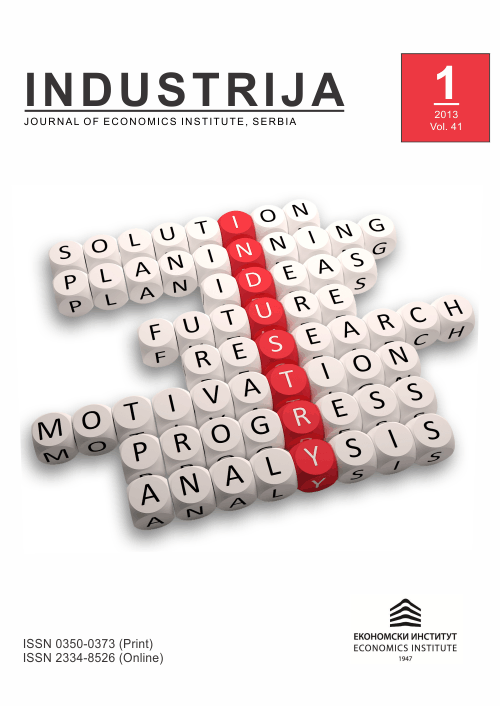The effects of international acquisitions in Serbia on status and engagement of human resources
Sažetak
In the past few decades globalization and deregulation of international economy has been noticeably accelerated. Consequently, new globalized business environment with numerous business opportunities as well as growing business risks has been made. The new business environment opened the door to intensive implementation of acquisitions as a market entry strategy. Foreign direct investments (FDI) in most of transition countries, including Serbia, predominantly come in the form of international acquisitions. There is a wide theoretical analysis of the effects of FDIs on target country economy. The overall conclusion is that green field projects, in comparison with international acquisitions, have more favorable effects on all aspects of host country’s economy. This paper examines the effects of international acquisitions in Serbia on work practices, wages and productivity using the analysis of the financial statements and the results of survey carried out among the foreign investors. It was found that decline of employment; productivity growth and increase in real wages are the results of the acquisitions. The survey also shows that the foreign investors invested in training and development of the acquired employees.
Reference
Bergsman, J., Broadma, G.H., & Drebentsov, V. (2000). Improving Russia's Policy on Foreign Direct Investment. World Bank. Working Paper 2329.
Campos, F.N., & Yuko, K. (2002). Foreign Direct Investment as Technology Transferred: Some Panel Evidence from the Transition Economies. University of Michigan Business School: William Davidson Institute. Working Paper 438.
Đuričin, D. (2005). Strategija konkurentnosti Srbije 2005-2010. (pp. 10-33). Kopaonik: SES.
-EBRD. (2011). Transition Report 2011. London: EBRD.
Egert, B., Drine, I., Lommatzsch, K., & Rault, C. (2002). The Ballas Samuelson effect in Central and Eastern Europe: Myth or Reality. University of Michigan Business School: William Davidson Institute. Working Paper 483.
Fagerberg, J., & Verspagen, B. (2002). Technology-Gaps, Innovation-Diffusion and Transformation: An Evolutionary Interpretation. Research Policy, 31(8/9), 1291-1304.
Kalman, K., & Hunya, G. (2000). Privatization and FDI in Central and Eastern Europe. Transnational Corporations, 9(1), 39-67.
Krishnan, H.A., Hitt, M.A., & Park, D. (2007). Acquisition Premiums, Subsequent Workforce Reductions and Post-Acquisition Performance. Journal of Management Studies, 44(5), 709-732. doi:10.1111/j.1467-6486.2006.00672.x
Mencinger, J. (2009). The "Addiction" with FDI and Current Account Balance. In Inostrani kapital kao faktor razvoja zemalja u tranziciji. Kragujevac, Serbia.
Meyer, K.E. (2002). Management challenges in privatization acquisitions in transition economies. Journal of World Business, 37(4), 266-276. doi:10.1016/S1090-9516(02)00093-7
Mišun, J., & Tomšk, V. (2002). Does FDI Crowd in or Crowd out Domestic Investment. Eastern European Economics, 40(2), 38-56.
Obloy, K., & Thomas, H. (1998). Transforming Former State Owned Companies into Market Competitors in Poland: The ABB Experience. European Management Journal, 6(4), 390-399.
Rakita, B. (2006). Međunarodni biznis i menadžment. Beograd: Ekonomski fakultet.
Ranđelović, S., & Marković, D. (2009). Role of Transfer Pricing in Contemporary Business. In Proceeding International Symposium Economy and Business. Sunny Beach Bulgaria.
Santalainen, T., & Leimman, J. (2003). Straddling for Market Space: Transforming Estonian State Owned Enterprises Toward a Free Market Orientation. International Business & Economics Research Journal, 2(9), 75-89.
Scweiger, D., Csizar, E., & Napier, N. (2002). Implementing International Mergers and Acquisitions. Human Resources Planning, 16(1), 53-70.
Shekshnia, S. (1998). Western multinationals' human resource practices in Russia. European Management Journal, 16(4), 460-465. doi:10.1016/S0263-2373(98)00022-X
-UNCTAD. (2000). World Investment Report 2000 - Cross border Merger and Acquisitions and Development. Washington: UNCTAD.
World, B. (1996). From Plan to Market. Washington: World Bank.
-World Bank. (2000). Transition the First Ten Years. Washington: World Bank.

